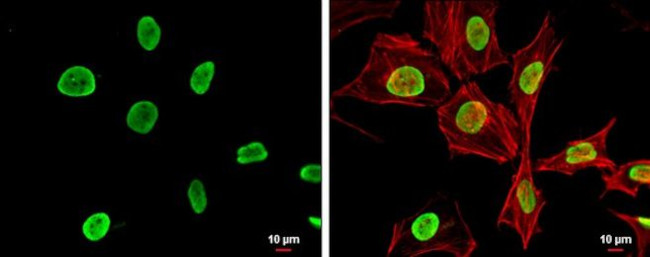Search Thermo Fisher Scientific
Invitrogen
H4ac pan-acetyl (K5,K8,K12,K16) Polyclonal Antibody
图: 1 / 6
H4ac pan-acetyl (K5,K8,K12,K16) Antibody (PA5-32029) in ICC/IF

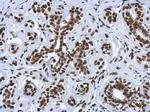
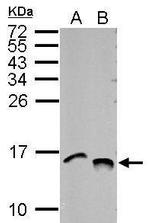
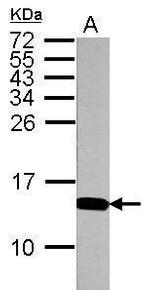
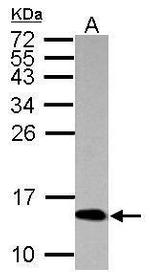
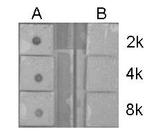
产品信息
PA5-32029
种属反应
已发表种属
宿主/亚型
分类
类型
抗原
偶联物
形式
浓度
纯化类型
保存液
内含物
保存条件
运输条件
RRID
产品详细信息
Recommended positive controls: HeLa, NIH-3T3, BCL-1, PC-12, TGW.
Predicted reactivity: Mouse (100%), Xenopus laevis (100%).
Store product as a concentrated solution. Centrifuge briefly prior to opening the vial.
靶标信息
Histones are basic nuclear proteins that are responsible for the nucleosome structure of the chromosomal fiber in eukaryotes. Two molecules of each of the four core histones (H2A, H2B, H3, and H4) form an octamer, around which approximately 146 bp of DNA is wrapped in repeating units, called nucleosomes. The linker histone, H1, interacts with linker DNA between nucleosomes and functions in the compaction of chromatin into higher order structures. This gene is intronless and encodes a member of the histone H4 family. Transcripts from this gene lack polyA tails but instead contain a palindromic termination element. This gene is found in the large histone gene cluster on chromosome 6.
⚠WARNING: This product can expose you to chemicals including mercury, which is known to the State of California to cause birth defects or other reproductive harm. For more information go to www.P65Warnings.ca.gov.
仅用于科研。不用于诊断过程。未经明确授权不得转售。
生物信息学
蛋白别名: acetyl Histone H4; Acetyl-H4 K5 K8 K12 K16; Acetyl-H4 Lys5 Lys8 Lys12 Lys16; Acetyl-Histone H4 K5 K8 K12 K16; Acetyl-Histone H4 Lys5 Lys8 Lys12 Lys16; H4 ac pan-acetyl; H4 histone family, member A; H4 histone family, member E; H4 histone family, member I; H4 histone family, member J; H4 histone family, member M; H4 histone family, member N; H4 histone, family 2; H4ac; H4K12; H4K12a; H4K12ac; H4K16; H4K16ac; H4K5; H4K5,8,12,16ac; H4K5ac; H4K8; H4K8ac; H4Lys5,8,12,16ac; HIST1H4; histone 1, H4a; histone 1, H4b; histone 1, H4e; histone 1, H4i; histone 1, H4j; histone 2, H4; histone 2, H4a; Histone 4; Histone 4 family, member M; histone 4, H4; Histone Cluster 4; histone family member; Histone H4; Histone H4 acetyl; Histone H4A; Histone H4K12; Histone H4K16; Histone H4K5; Histone H4K8; histone IV, family 2
基因别名: dJ160A22.2; FO108; H4; H4-12; H4-16; H4-53; H4/A; H4/B; H4/C; H4/D; H4/E; H4/G; H4/H; H4/I; H4/J; H4/K; H4/M; H4/N; H4/O; H4/p; H4C1; H4C11; H4C12; H4C13; H4C14; H4C15; H4C16; H4C2; H4C3; H4C4; H4C5; H4C6; H4C8; H4C9; H4f16; H4F2; H4F2iv; H4FA; H4FB; H4FC; H4FD; H4FE; H4FG; H4FH; H4FI; H4FJ; H4FK; H4FM; H4FN; H4FO; H4M; HIST1H4A; HIST1H4B; HIST1H4C; HIST1H4D; HIST1H4E; HIST1H4F; HIST1H4H; HIST1H4I; HIST1H4J; HIST1H4K; HIST1H4L; Hist1h4m; HIST2H4; HIST2H4A; HIST2H4B; HIST4H4; X04652
UniProt ID: (Human) P62805, (Mouse) Q811M0, (Mouse) P62806
Entrez Gene ID: (Human) 8359, (Human) 8366, (Human) 8367, (Human) 8294, (Human) 8363, (Human) 8370, (Human) 121504, (Mouse) 326619, (Mouse) 326620, (Mouse) 319158, (Mouse) 97122

